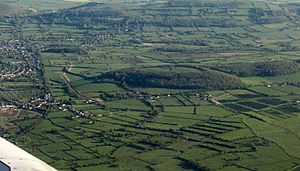Banwell Camp facts for kids
Quick facts for kids Banwell Camp |
|
|---|---|

Banwell Hill from the air
|
|
| Location | Banwell, Somerset, England |
| Area | 15 acres (6.1 ha) |
| Built | Bronze Age – Iron Age |
| Official name: Banwell Camp | |
| Reference no. | 194460 |
| Lua error in Module:Location_map at line 420: attempt to index field 'wikibase' (a nil value). | |
Banwell Camp is an ancient hill fort found in Somerset, England. It was built during the Iron Age, a very long time ago. This special site is about 1.6 miles (2.6 km) east of the village of Banwell.
A "univallate" hill fort means it has a single set of defenses. At Banwell Camp, you can still see parts of a bank and ditch that are about 4 meters (13 feet) high. Some old tools and items found here even date back to the Bronze Age and Stone Age. In the late 1950s, J.W. Hunt from the Banwell Society of Archaeology explored the site.
What is a Hill Fort?
Hill forts are large, fortified settlements. They were built on hills, usually during the Late Bronze Age and Early Iron Age. This was roughly around 1000 BC. People used natural high ground to help protect their communities.
These forts often had strong walls, ditches, and banks. They were like ancient castles or protected towns. Many hill forts are found across Britain.
Why Were Hill Forts Built?
Historians and archaeologists have different ideas about why hill forts were built. Some think they were military sites. They might have been used to defend against invaders from other parts of Europe. Or perhaps they were built by invaders themselves.
Another idea is that they were a reaction to problems within society. As more people lived in Britain, there was more pressure on farming and resources. This could have led to arguments and even small wars between groups. Hill forts might have been safe places during these times.
A popular idea is that the discovery of iron changed society. Iron ore was found in different places than the tin and copper needed for bronze. This changed how people traded goods. Old leaders might have lost their power, and new groups became important.
Archaeologist Barry Cunliffe believes that a growing population played a role. He suggests that hill forts offered protection when tensions turned into fighting. He doesn't think they were built only because there was a constant war. Instead, they were useful strongholds when needed.
A Local Legend
There is a local folktale about Banwell Hill. It tells the story of the Banwell Cross. This cross is carved into the earth on the hill. The legend says that the Devil kept destroying the villagers' attempts to build an upright cross. So, to trick him, they decided to create a cross lying flat on the ground instead!

